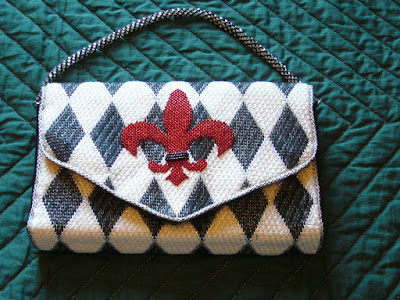Early last year we started a self-help craft group, Leith Friendly Crafters, at Leith Library under the auspices of
Inspiring Leith. The group was advertised as being for all skill levels and none. The idea was that local people who wanted to learn to knit, crochet, quilt or embroider could come along and someone in the group would teach them the basics.
In June last year my friend Hannah suggested that it would be a good idea if there was something people could try at Leith Festival, and could I design something?
Well, yes.
That was the start of "Inspiring Leith".
This is Hannah, at Leith Festival, hiding from the rain. The framed canvas has the basic design drawn on it, waiting for anyone to show an interest. It poured wet all day, but Leithers are hardy folk. Rain, snow, hail, thunder, they will still go to the Festival.
I started this with no real colour plan or stitch guide, only a book of stitches and a box of different colours and types of thread - wools, perle, variegated and self coloured. The point was to encourage and enthuse, and I felt that giving them the choice people would feel more part of the project.
To further encourage them, I made a note of the given names of everyone who chose a colour, stitch and letter and promised that they would all get a mention when the hanging was completed.
After the festival, our group continued to meet in Leith Library and I continued to invite passers-by to have a shot, choose a colour and stitch a little.
As you can see, it brought out some interesting colour combinations, and surprisingly little white and green, the colours of Hibernian, the local football (soccer) team. Once the letters and the tower were completed I had to decide how it was to be finished.
As it was to be a hanging, and frequently moved, I didn't want it to be too heavy and bulky, so I decided that a skip stitch in a neutral shade was the best option. Luckily, I had in hand a good deal of a fawn Appletons Crewel wool which, on testing, took nothing away from the lettering or the tower.
I finished it with a colourful bias binding.
I was impressed by some of the stitch choices, and though I thought some of them might not be that appropriate to the letter, I went with them, showing them how to do the stitch and giving advice where it was needed. Here are some close-ups of the chosen stitches.
I had promised that everyone who worked on this would have their name recorded, so I wrote them on a large sheet of paper, pinned and tacked it to a piece of calico and stitched through it using back-stitch, then I attached it to the back and put on the binding and hanging loops.
So there you are, Angela, Louisa, Georgia, Gordon, Anna-Maria, Christine, Hannah, Muhammed, James, Eva, Eshal, Alice and Sanya. When you see Inspiring Leith hanging, you can point to it and say "I did some of that," and if anyone doubts you, your name is on the back.
Next week I shall be handing this to Hannah, and I believe that its first outing will be at the Inspiring Leith stall at the old police box at Shrubhill (Leith Walk) on Saturday 27th June (11.00 am to 2.00 pm).
I didn't count how many hours this took as it was a community project, but it was great fun and I met some lovely people. It was, incidentally, a great way to use up part of my 'Stash'.
So why not boogie down to your local library and see if they have any craft groups, and if they don't, start one.
I certainly intend to be back at Leith Library when Lockdown is lifted and Jane-Beth lets me out again.


















































